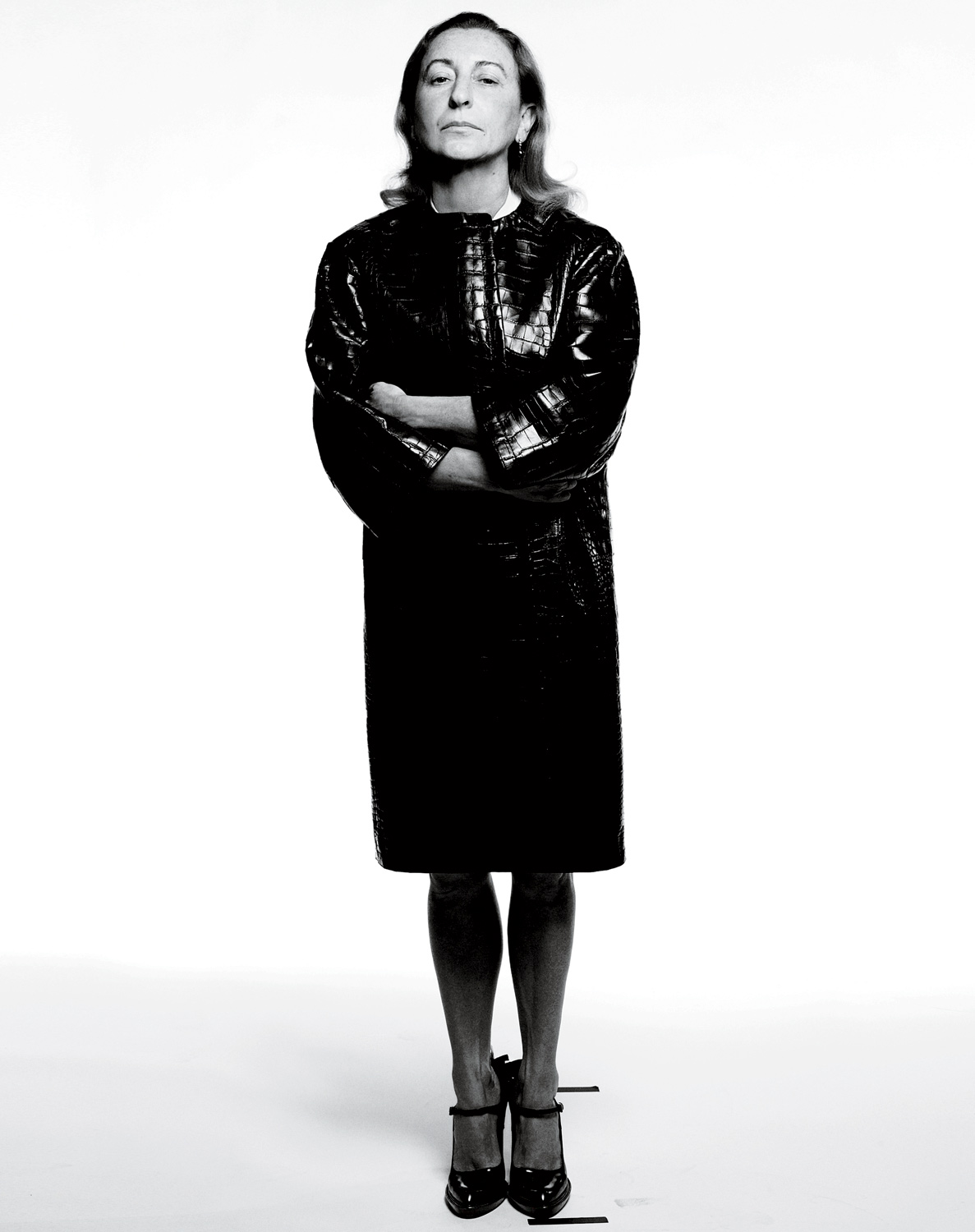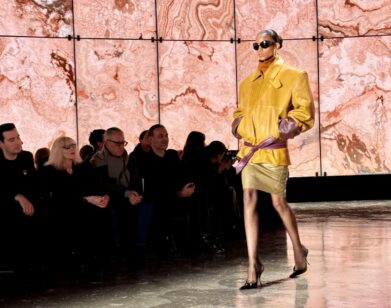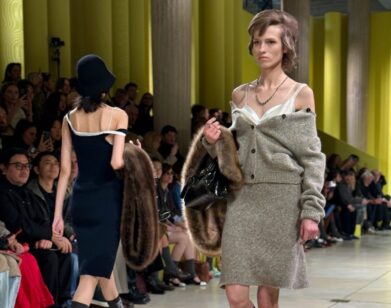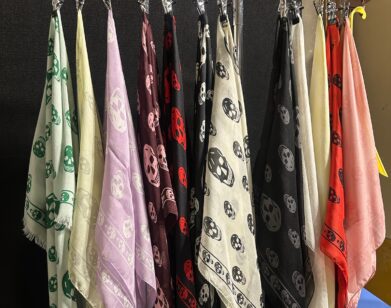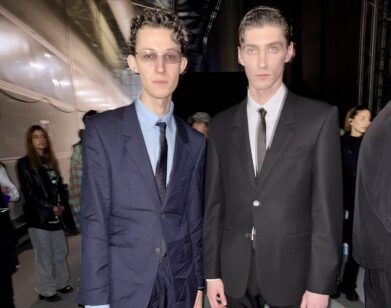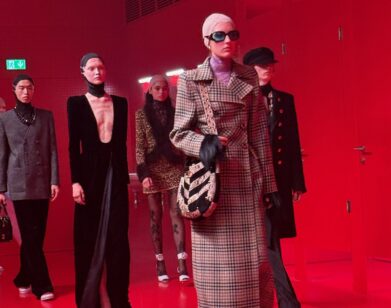Miuccia Prada
I would say there is no prada woman. i’m interested in women in general. i don’t have any kind of preference. i do what i think is right.Miuccia Prada
Cartoon car prints might be the least expected motif for the elegant pintucked blouses, high-waisted pencil skirts, and silk car coats comprising Prada’s Spring 2012 women’s collection. But then Miuccia Prada, the label’s creative director, who lists both a doctorate in political science and a brief stint as a mime on her résumé, can be counted on every season to confound expectations. In the two-plus decades since Prada debuted a certain black nylon utility backpack, instantly making that anti-luxury accessory a must-have bag, she has displayed a knowing sense of irony that has helped establish her as the thinking person’s go-to designer. At the same time, she has transformed the heritage leather-goods house, founded in 1913 by her grandfather Mario, into a global fashion empire valued at a reported $13 billion.
Prada has also become a power player in the worlds of contemporary architecture and art. Through the Fondazione Prada, established in 1993, Prada and her husband, Patrizio Bertelli have acquired an ever-expanding collection of more than 700 works by artists varying from Walter De Maria to Michael Heizer and have acted as early champions for next generation stars such as Francesco Vezzoli and Carsten Höller. (It was at Höller’s recent exhibition “Experience” at the New Museum, in New York, where the photographs for this story were shot.) She has collaborated with architect Rem Koolhaas’s Office for Metropolitan Architecture on Prada’s avant-flagship stores in New York and Los Angeles, and Koolhaas has designed a museum and cultural center for the foundation in Milan that will be unveiled in 2013. The Fondazione Prada also opened an exhibition space at the 18th-century palazzo Ca’ Corner della Regina in Venice this past June.
At the same time, Prada remains as intimately committed to fashion as ever, crafting highly wearable separates that intelligently play on the many aspects of femininity. Who but Prada could so effortlessly toe the line between conceptual and commercial, managing to make wader boots, banana prints, and now ’50s-style hot rods eminently desirable? Sonnet Stanfill, curator of 20th-century and contemporary fashion at the Victoria and Albert Museum in London, recently caught up with the designer in her Milan studio to discuss her passion for fabrics, the curiosities of golf clothing, and the notion of sweetness.
SONNET STANFILL: In designing your spring collections, you took inspiration from many visual and cultural references. Can you talk about that process?
MIUCCIA PRADA: For the men’s collection, I tried to understand where men accept newness, and usually it’s in a sports shoe or in a T-shirt. I wanted to try to push some freedom into the men’s clothes. I looked at the places where they do take risks. I saw an incredible and strange book about golfers where they were wearing the most crazy, silly combinations—completely outrageous. I started thinking about that culture, which I completely don’t know because I’m not interested in golf at all.
STANFILL: Very whimsical.
PRADA: Yes, and fun. And, of course, I played off what is allowed for men in golf—usually a vibrant shirt and crazy, crazy colors and hats. So that’s how it started. I had the same spirit in mind for the women. Also, for the fall-winter 2011 season, the show was held on a set that represented a private and closed space—actually the interior of a house. For spring, it is the idea of traveling freely and taking risks, and finding yourself being outside and open to experiences. It’s about a woman’s role as a symbol of possibilities.
STANFILL: So what about the car motif?
PRADA: All of a sudden I had this idea of doing cars. The car is such an obvious symbol and contains many different symbolic meanings, no? Actually there is a saying in Italian: Donne e motori—or “women and cars” . . . It’s a joke, but at the same time, it contains different, subtle truths.
STANFILL: What else were you thinking about?
PRADA: What also came to my mind was the word sweet. I wanted to make this collection sweet, which is taboo in fashion. I knew it was such a difficult subject that if I didn’t have the right concept, then I wouldn’t do it. I worked with sweet materials and shapes: Sangallo lace and Swiss rebrode lace and pastel colors. Little by little, it started coming together. By chance, I received a picture of a new work by Walter De Maria and it showed the exact same car I was working on. I said, “Okay, this is the sign of destiny,” and I did it.
STANFILL: When I asked you about your spring collections, you said it started with the menswear—bringing the whimsy from the men’s collection to the women’s. Do you think of your collections as couples, as a pair walking down the street, or are they separate?
PRADA: No, they are separate. But, of course, my work flows between men’s, women’s, and Miu Miu, so it’s like a triangle. But basically I’m trying to make men more sensitive and women stronger.
STANFILL: I think you achieved that very successfully. Has the Prada woman evolved under your direction?
PRADA: I would say there is no Prada woman. I’m interested in women in general. I don’t have any kind of preference. I do what I think is right.
STANFILL: Do you usually work with the same textile producer?
PRADA: No, absolutely not. We change according to the subject.
STANFILL: And they’re international? Swiss, Italian . . .
PRADA: Usually they are Italian or French, but some of the French producers are in great difficulty—and so are some of them here, too. I get so passionate about fabrics and prints, and we are able to do and redo, and we experiment with so many different techniques with these producers. I have to say, one of the advantages of being a big company is that you ask for two or three things and you get 20 or 30. They are really passionate about keeping the factories open. They have incredible knowledge, but no one is interested anymore. So my work is also about that.
I wanted to make this collection sweet, which is taboo in fashion . . . If I didn’t have the right concept, then I wouldn’t do it.Miuccia Prada
STANFILL: About sustaining history?
PRADA: Yes. I wouldn’t say that this is a political point. It’s very important . . . It’s just a pity. Let’s hope that these people don’t have to close down their businesses.
STANFILL: It sounds like you are sustaining many of them.
PRADA: In a way.
STANFILL: I’m sure you’ve been asked this a lot, but when you were younger, did you ever think about a life in fashion?
PRADA: I always loved aesthetics. Not particularly fashion, but an idea of beauty. At that time, with the politics of the period and feminism and so on, to deal with beauty and fashion as a subject was so uncomfortable, but I did it because I liked it so much. So I felt really uncomfortable until probably a few years ago.
STANFILL: Really? And now are you comfortable?
PRADA: Now I’m comfortable because I see that my work is an instrument for so many other things and that people love fashion in general. It’s a popular medium. So through the brand—through being known because of the clothes—I can do things that I couldn’t do otherwise.
STANFILL: What are the other things you’re thinking of when you say that? Do you mean art projects?
PRADA: Yes, absolutely, the art. But also, for instance, Miu Miu commissioned some films by female directors. I would also say I try to make all that I do more intelligent and introduce intelligence through what I do. I have my work and I have the art foundation, and I try to do the best I can in every single aspect.
STANFILL: I think it’s been very interesting to see your foundation and projects like the palazzo Ca’ Corner della Regina, in Venice, become a really exciting showcase for contemporary art. What are your plans for the palazzo?
PRADA: The exhibitions there are much more difficult than the ones here. The palazzo itself limits possibilities. We are building a new permanent space for the foundation, here in Milan, and I think that when we have the building, it will be easier because there will be many different spaces so we can also do a lot of quick, small, clever shows, where everything doesn’t have to be so thought-out. More movement, more improvisation. With Venice and the palazzo, you have to think about everything much more.
STANFILL: I know you have had a very long and close relationship with Rem Koolhaas, who designed the new cultural center for the foundation. I’m wondering how that relationship has evolved and what it’s like for your business to work so closely with an architect.
PRADA: It’s a very easy relationship. And at the same time that he’s involved in the bigger projects, like the museums, I think he is also interested, with his OMA team, in keeping his eye on the smaller projects like the fashion show spaces.
STANFILL: I’m curious, personally, about a bigger subject: the position of Italian fashion in the world today. I’m working on an exhibition for the V&A in London on Italian fashion from the ’50s to the present, and I’m wondering if you think it’s still possible to refer to Italian fashion as Italian fashion, or does it not exist anymore? Is it all international?
PRADA: Today, yes, it is international. There was a moment, I’d say in the ’50s, when Italian haute couture was probably copied a little bit by French designers, but I’m not so sure now. And later there was a big moment for designers, like Armani and Versace. Now, I would say, it’s very international.
STANFILL: Do you think it’s because of changes with Italian manufacturers, the textile producers, and the artisanal quality?
PRADA: Yes, but they also produce for the French, and the French produce a lot here, I think.
STANFILL: So even if the location for manufacturing is Italy, the destination is the rest of the world.
PRADA: Well, what do you think? Because I believe you have studied the subject more than I have. [laughs]
STANFILL: I think there are still traditions when it comes to the locations of manufacturing.
PRADA: That is true. But it’s not only for Italians.
STANFILL: The material is not destined for Italy. But what is unique are these little clusters of businesses that feed each other, and so the story may be that that’s the heritage. But perhaps in the future the danger is that this patrimony, artistically, disappears.
PRADA: Yes, it’s going to disappear quickly.
STANFILL: But I hope the Chinese will help support it because they are such big consumers—the MADE IN ITALY label, for them, is still very important. That’s my hope.
PRADA: I’m afraid that it will soon disappear because, as I told you, it’s really a struggle to produce. Young people don’t want to become artisans, even if we’re trying to create a school for this. In Italy it’s a problem . . .
For spring, it is the idea of traveling freely and taking risks . . . It’s about a woman’s role as a symbol of possibilities.Miuccia Prada
STANFILL: Well, I suppose it’s the same thing that happened in France . . . So back to Prada and the bigger picture. Thinking about the future of the label and your legacy and passing the baton to the next generation, where would you like Prada to be in 20 years?
PRADA: The next generation is here already. There are so many young kids working here now. Old and young—we have the combination of the generations, so I don’t feel it’s something to think about. They’re already all here. They work together all the time since . . . I would say since forever.
STANFILL: Do you have an idea of what you would like Prada to be doing in 10 years, in 20 years? More of the same? An expanded idea?
PRADA: I think we will improvise. We, as designers, have a job with so many possibilities and connections. We are connected to so many different portals, from art to movies to music to design. Fashion is always evolving. Actually, the field is huge. I don’t think there is another profession that is so open to so many possibilities. I would say that clothes are an excuse for living in the world.
STANFILL: Are there any people or historical figures you think are especially stylish? Anyone you admire, either today or from another generation?
PRADA: Everybody knows that I don’t have a muse. I’m not interested in that. When I talk with people, I don’t even see what they are wearing . . . No, I recognize it if it’s something particularly nice and interesting. I see the exception.
STANFILL: I think it’s very noticeable in comparison to, say, England, where I live, and America, where I’m from, that the Italian fashion houses have a very long tradition of supporting the arts, and perhaps Prada is the ultimate example of that because of your many contributions. But do you think, in the current economic climate, that that is going to disappear in Italy? Or do you think that tradition will continue?
PRADA: No, I think more and more, if you live in the current world—and live internationally—it’s all a mix of interests, and the same people who are interested in fashion are also interested in movies, art, and culture. In Italy, we have a strong tradition of patronage since the 15th century, and, actually, the fashion world is very active and generous, despite the fact that it is not very well respected—or at least not as much as it should be.
STANFILL: Diego Della Valle is restoring the Colosseum and Spazio Krizia, which, though it’s not as vital as it used to be, is still doing programming, and there’s the Max Mara foundation.PRADA: Yes, absolutely. And it’s strange that it’s not recognized. But we are fashion, a strong component of the country’s economy.
STANFILL: Absolutely. This is something that needs to be corrected. I will make that the mission of my exhibition.
PRADA:[laughs] No, but it’s true, because fashion people are open and generous. They do for themselves. They also do for their friends. But they do it—that’s the most important thing.
Sonnet Stanfill is curator of 20th-century and contemporary fashion at the Victoria and Albert Museum, London.
Click here to see the Prada Spring 2012 collection.

